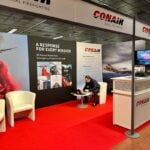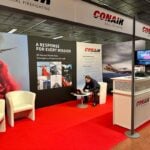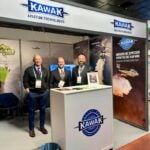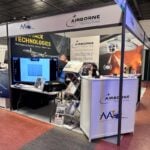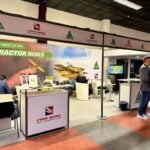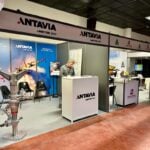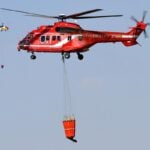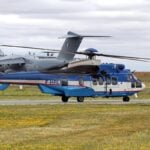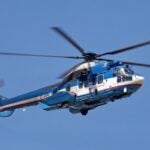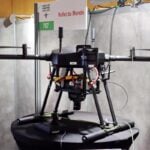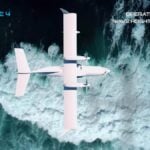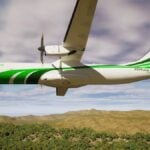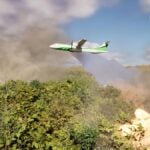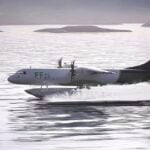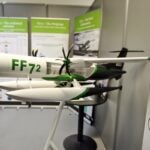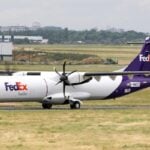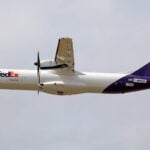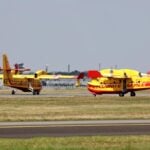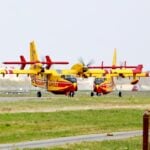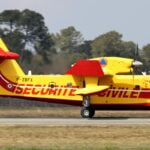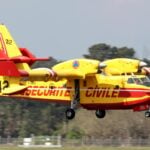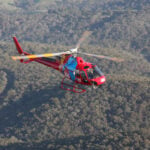Innovations and New Aircraft Unveiled at the 2025 Bordeaux Conference
By Babak Taghvaee
The Aerial Firefighting Conference 2025, hosted by the General Directorate of Civil Security and Crisis Management of France and organized by Tangent Link, took place in Bordeaux on March 26 and 27, 2025. This key event, held in partnership with the French Ministry of the Interior and Sécurité Civile, brought together some of the world’s leading companies in aerial firefighting, along with representatives from government agencies, defense ministries, and air forces from several European countries. The conference provided a platform for sharing the latest developments in firefighting tactics and technologies, with a particular focus on the future of aerial firefighting (AFF) capabilities.
Over the two-day event, attendees not only exchanged knowledge and expertise but also showcased their most recent innovations in firefighting equipment, drones, and aircraft. Some of these new developments are expected to revolutionize the aerial firefighting industry in Europe and beyond in the next five years. During the conference, the author had the opportunity to meet with project managers and designers behind the new firefighting aircraft, which were unveiled for the first time at this significant event in Bordeaux. During this event, four new air tankers, Metrea FireSwift, 19-01 Holding WF-X Waterfall, Kepplair Evolution KE-72 and Positive Aviation FF-72.
Reshaping the Future of Aerial Firefighting in Europe
Bordeaux was chosen as the location for the 2025 edition of the Annual Aerial Firefighting Conference due to its vulnerability to wildfires, particularly during the summer months. In August 2022, one of the largest wildfires in the region consumed 74 square kilometers of vegetation, forests, and villages in the south and southeast of Bordeaux. When French Civil Security was unable to control the blaze alone, aerial tankers, fire trucks, and firefighters from several countries, including Greece, Italy, and Romania, were deployed to assist in extinguishing the fire.
The first day of the conference featured presentations from program managers and officials from the world’s top firefighting corporations, starting with Sean D. Navin, Program Director at Amentum Aviation. Amentum, an operator and maintainer of fixed-wing aircraft for Cal Fire (California Department of Forestry and Fire Protection), was represented by Navin, who discussed the company’s global role in aviation services and its long-standing partnership with Cal Fire. This collaboration has become a benchmark for aerial firefighting programs worldwide.
Later that day, Alfonso Andrade Otero, Head of the Aerial Assets Unit at the Spanish Ministry for Ecological Transition & Demographic Challenge, and Captain Rubén Prieto Corral, Aeronautical Engineer with the 43 Group of the Spanish Air Force, provided an overview of Spain’s aerial firefighting fleet. They focused on the ten Canadair CL-215Ts and four CL-415s in service with the Spanish Air Force’s 431 Squadron, based at Torrejón Air Base in Madrid.
Otero and Corral also discussed the challenges Spain faces regarding fleet upgrades, market tensions, and increasing costs in the aviation sector. Additionally, they detailed Spain’s ongoing projects, such as the acquisition of the DHC-515 and the planned modernization of the CL-215T fleet. On April 19, 2024, the Spanish government announced a €375 million upgrade program to modernize the fleet, which includes the purchase of seven new De Havilland Canada DHC-515 amphibious aircraft, with two planned to be procured through the European Civil Protection Mechanism.
On the second day of the conference, presentations focused on firefighting tactics and strategies developed for tackling wildfires across Europe and other regions. Chris Siok, Battalion Chief of the Air Operations Section at the County of Los Angeles Fire Department, and Mike Sagely, a senior pilot with the same department, gave a briefing on the department’s response to the Los Angeles wildfires.
Later in the day, Matthias Ott, Head of the Department for “Situation, Operations & Technical Matters of Fire Departments & Disaster Protection; Preventive Fire Protection” in the State of Bavaria, and Stephan Brust, Deputy Chief of the Bavarian State Fire Academy, delivered a presentation on the unique forest structures and firefighting challenges in Germany. They discussed the special challenges of fighting fires in forests contaminated by munitions and explored the advantages and disadvantages of fixed-wing aircraft versus helicopters in forest firefighting operations in Germany.
New Air Tankers Unveiled During the Conference,
Air Tractor and Canadair have long been the leading manufacturers of aerial firefighting aircraft, with many of their models being vital in the fight against wildfires across Europe and beyond. The Canadair CL-215/415 Type-II tankers and Air Tractor AT-802 Fire Boss Type-III tankers have remained the cornerstone of aerial firefighting operations, particularly due to their water-scooping capabilities, allowing them to refill their tanks directly from bodies of water. Over the past few years, some of Europe’s major operators of the CL-215 and CL-415 have considered acquiring the new DHC-515 as a replacement or complementary asset to address the increasing frequency and severity of wildfires.
As of March 2025, 22 DHC-515s had already been ordered, with deliveries planned for Croatia (2), Greece (7), Indonesia (2), France (2), Portugal (2), and Spain (7) starting in 2028. However, given the production timelines of the DHC-515, which could take years to fulfill customer demand, several other aircraft manufacturers have explored alternatives. These alternatives aim to address the increasing global demand for Type-II air tankers, not only to replace the Canadair and Air Tractor models but also to offer viable options for the Conair Dash 8 Q400MRE and Q400AT land-based aircraft.
At the Aerial Firefighting Conference in Bordeaux on March 26-27, 2025, several manufacturers unveiled their solutions for Type-II air tankers, signaling the industry’s commitment to meeting the growing global demand for advanced firefighting aircraft:
– Metrea FireSwift: A New Contender in Type-III Aerial Firefighting,
Conair’s Dash 8 Q400AT and Q400MR platforms have long been staples in the Type-II aerial firefighting category, thanks to their versatility and performance. These aircraft, developed from the Bombardier Dash 8 regional airliner, have proven to be highly effective in wildfire suppression and other firefighting operations. Over the past two decades, Conair has successfully manufactured nearly one aircraft per year, reaching a total of 20 Dash 8-based aircraft by December 2024. This includes a fleet of eight Dash 8 Q400s in service with the French Ministry of Interior’s Sécurité Civile as of March 2025.
As demand for land-based Type-II air tankers continues to grow, and given the proven success of the Dash 8 platform, other aviation companies have begun to explore it as a basis for their own aerial firefighting solutions. Metrea Aero, the world’s largest operator of privately owned tanker aircraft, with a fleet including 12 KC-135FRs and three KC-135Rs (with three more KC-135RGs joining in 2025 after their retirement from the French Air and Space Force), has developed its own Dash 8-based aerial firefighting aircraft: the FireSwift.
Distinct from the Conair Q400 platform, the Metrea FireSwift is based on the shorter Dash 8-300 variant, designated the DHC-8-300AFF (Aerial Firefighting). While the Conair Q400AT/MR is a Type-II air tanker with a capacity of 2,640 US gallons (10,000 liters), the FireSwift is a Type-III tanker with a reduced capacity of 1,500 US gallons (5,700 liters). Despite the smaller tank size, the FireSwift’s reduced weight increases its G-limit, allowing the aircraft to perform water drops at lower altitudes and closer to the ground, providing greater precision in firefighting operations.
One of the key features setting the FireSwift apart from its competitors is its ability to perform nighttime firefighting operations. This is made possible by its WESCAM MX-15 Electro-Optic/Infrared (EO/IR) turret mounted under the nose of the aircraft, allowing it to conduct firefighting operations even in low visibility conditions. This advanced technology enables the FireSwift to operate effectively during night hours or in areas where traditional firefighting methods may be less effective.
In addition to its firefighting capabilities, the FireSwift is equipped with advanced communication and datalink systems, including Starlink Aviation’s BLOS (Beyond Line of Sight) communications and a TAK (Team Awareness Kit) server. These systems provide critical situational awareness by tracking ground personnel, offering target correlation, and delivering emergency support to both firefighters on the ground and national command and control units. The integration of these cutting-edge technologies also allows the FireSwift to perform a variety of other missions, including maritime patrol, search and rescue, fishery protection, and counter-narcotics operations, all in a range of weather conditions.
With its enhanced versatility, precision, and advanced technological features, the Metrea FireSwift represents a significant addition to the growing fleet of aerial firefighting aircraft designed to meet the increasing demands of wildfire suppression and emergency response worldwide.
– Kepplair 72: A New Type-II Air Tanker with Multifunctional Capabilities,
The ATR-72 passenger aircraft, particularly the -600 series variant, has long been a key competitor to the Dash/DHC-8 in the regional propliner market. Building on the proven ATR-72 platform, Kepplair Evolution has developed a versatile Type-II air tanker that also serves as a cargo transport aircraft when not engaged in firefighting operations. The new aircraft, named the Kepplair KE-72 ‘Forest Keeper’, is designed to carry both water tanks for firefighting and cargo for freight missions, offering a unique combination of operational flexibility.
Under development since 2012, the KE-72 is slated to have its first prototype flight in Toulouse in 2027. It features a reinforced cargo cabin floor capable of housing two large water tanks, they together are capable of carrying up to 1,981 gallons (7.5 tons) of water or fire-retardant materials—or a combination of both. When the aircraft is not in use for firefighting, the tanks can be removed via the aircraft’s large cargo door, and a reinforced cargo floor can be installed. This modification allows the KE-72 to carry a maximum of 7.5 to 8.5 tons of freight, making it highly versatile for a range of missions.
The KE-72 also offers the capability for medical evacuation, with the cabin able to be configured to accommodate up to six patients on stretchers. This further expands the aircraft’s operational potential, allowing it to serve not only in firefighting but also in emergency response and humanitarian missions.
One of the key goals of the KE-72’s design is to provide a Type-II air tanker with lower maintenance and operational costs compared to its competitors, such as Conair’s Q400AT/MR. Kepplair’s focus on affordable ownership includes low purchase or leasing costs, easy maintenance for high availability, and a fuel-efficient design, offering savings of up to 30% compared to similar aircraft in the same class.
The aircraft’s flying characteristics are tailored for optimal firefighting performance, with impressive maneuverability at low speeds, precise targeting capabilities at low altitudes, and a high rotation speed of 318 knots (590 km/h). Its extended range will also enable easy access to a wide variety of airports, making it an efficient and flexible asset for firefighting operations.
The KE-72 has already completed its pre-design review in March 2025, with the final design review scheduled between March 2025 and March 2026. The first and second prototypes are set to be manufactured between March 2026 and 2027, with the first flight expected to take place between July and December 2027. Deliveries to customers are planned to begin in 2028, marking a new and affordable solution for Type-II aerial firefighting operations worldwide.
– Positive Aviation FF-72: An Amphibious Air Tanker with Enhanced Capabilities,
Similar to the Kepplair KE-72, the Positive Aviation FF-72 is based on the ATR-72 platform but sets itself apart with its amphibious capability, allowing it to perform water scooping operations directly from bodies of water. This feature, combined with more powerful engines and a higher overall performance, positions the FF-72 as a promising candidate to replace aging fleets of CL-215s and CL-415s, offering an advanced alternative for firefighting operations.
The FF-72 is currently under development, with its first prototype scheduled to fly in Toulouse in 2027. Equipped with Pratt & Whitney PW127 engines, each producing 2,750 shaft horsepower (shp), the FF-72 boasts more powerful engines than the CL-415 and its successor, the DHC-515, which are powered by PW123 engines generating a maximum of 2,380 shp. This increase in engine power enables the FF-72 to achieve a higher maximum takeoff weight (MTOW) of 50,706 lbs (23,000 kg), which is significantly greater than the CL-415’s MTOW of 43,850 lbs (19,890 kg). The increased MTOW results in a higher water capacity for the FF-72—2,113 gallons (8 tons), compared to the CL-415’s maximum capacity of 1,622 gallons (6.4 tons).
In addition to its enhanced power and water-carrying capabilities, the FF-72 offers superior flight performance. The aircraft will have a cruise speed of 260 knots at FL180, a significant improvement over the CL-415’s 180 knots. The FF-72’s advanced floats, designed by Guillaume Gallant, Chief Engineer at Positive Aviation, will allow for a scooping approach speed of 98 knots, surpassing the CL-415’s scooping speed of 90 knots. These enhancements, combined with the removal of certain components, such as the anti-ice and pressurization systems used for high-altitude flights, make the FF-72 optimized for low-altitude firefighting operations.
The FF-72 was unveiled at the Bordeaux Aerial Firefighting Conference on March 25, 2025, where Positive Aviation also announced its first sales agreement. The company signed a letter of intent with Bridger Aerospace, a U.S.-based operator of six CL-415EAFs (modernized CL-215s with turboshaft engines), for an order of ten FF-72s, with an option for an additional ten. This initial order highlights the growing interest in the FF-72 from operators seeking a high-performance amphibious air tanker to replace older firefighting aircraft.
With its amphibious capabilities, powerful engines, and superior flight characteristics, the Positive Aviation FF-72 offers a compelling solution for the evolving needs of aerial firefighting operations worldwide.
– 19-01 Holding WF-X Waterfall: A Revolutionary Amphibious Firefighting Aircraft,
The WF-X Waterfall, a highly anticipated amphibious aircraft designed by 19-01 Holding, is set to redefine the capabilities of aerial firefighting, as well as a range of other mission types. Initially developed in secret since 2011, the Waterfall is a versatile platform capable of performing various roles, including anti-submarine warfare, maritime patrol, and search and rescue. However, the latest development sees a firefighting variant tailored for the Vigili del Fuoco (Italian Fire and Rescue Service) and the Italian Navy. The first prototype of the WF-X is slated to fly in 2027 or 2028, marking the beginning of a new era for aerial firefighting.
The WF-X Waterfall is designed to surpass the CL-415 in virtually every aspect, both in size and performance. With a length of 25.25 meters and a wingspan of 32.45 meters, the WF-X is significantly larger than the CL-415, which measures 20.4 meters in length and 28.38 meters in wingspan. The WF-X is also powered by two much more powerful turboprop engines, each producing 5,000 horsepower—far more than the Pratt & Whitney Canada PW123AF engines of the CL-415, which deliver a maximum of 2,380 horsepower. This increase in engine power, combined with a cruise speed of 320 knots, ensures that the WF-X will have exceptional operational performance.
The WF-X Waterfall will have an impressive range of 2,600 nautical miles, making it an ideal platform for maritime search and rescue, as well as maritime patrol missions, particularly when compared to the maritime patrol variant of the CL-415 (the CL-415MP).
With a maximum takeoff weight (MTOW) of 30 tons, the WF-X will be classified as a Type-I large tanker. It will have the capacity to carry up to 12 tons of water, significantly surpassing the water capacity of many other Type-I tankers on the market, such as Boeing 737s, BAe-146s, and C-130s equipped with MAFFS II firefighting modules or Coulson Aviation’s RADS-XXL 4,000 US gallon roll-on/roll-off tanking system used by Cal Fire and Coulson Aviation.
The Waterfall’s amphibious design allows it to scoop water directly from bodies of water, a feature that sets it apart from other large tankers that require refueling at airports. This capability, along with its advanced performance specifications, positions the WF-X as a formidable player in both the firefighting and maritime patrol sectors.
In an exclusive conversation with Renato Sachetti, founder and CEO of 19-01 Holding, the author learned that the WF-X project is fully funded and has already passed several critical development milestones. The aircraft’s specifications were finalized in September 2021, its supply chain was established in 2022, and the production site was selected in May 2023. With the production of the first prototype already underway, testing is expected to begin in 2026, with its maiden flight planned for 2027 or 2028.
The WF-X Waterfall is set to become a game-changer in the world of aerial firefighting, combining powerful performance with advanced amphibious capabilities and a flexible design that allows it to serve multiple roles across various mission types. This aircraft will provide the firefighting community with a cutting-edge solution to tackle increasingly severe wildfire seasons and other emergency response operations.
French Companies Display Their Aerial Firefighting Products at Bordeaux Conference,
In addition to Positive Aviation and Kepplair Evolution, manufacturers of the FF-72 and KE-72 Type-II airtankers, several other French companies showcased their products and capabilities during the Aerial Fire Fighting Conference held in Bordeaux in March 2025. Safran Electronics & Defense, Airbus Helicopters, AgroDrone, and AirTelis were among the key players in the aerial firefighting sector who presented their innovative solutions at the event.
Safran Electronics & Defense featured their advanced EO/IR (Electro-Optical/Infrared) turret system, an essential tool for surveillance and targeting during firefighting operations, providing enhanced situational awareness for pilots and operators on the ground. Airbus Helicopters also displayed their contributions to aerial firefighting, which have been crucial in supporting large-scale fire suppression efforts around the world.
AgroDrone, based in Saint Aubin de Medoc near Bordeaux, specializes in the development of multirotor and first-person-view drones used for agricultural operations. However, they have adapted their technology for aerial firefighting purposes, designing drones for surveillance operations at test ranges. These drones are used by the French Directorate General of Armaments (DGA) to monitor the launch and impact of air-to-surface missiles and precision-guided bombs. In the event of a fire caused by a missile or bomb explosion, the drones quickly detect and report the fire’s location to firefighting teams for rapid response.
AirTelis, a primary contractor for the French Air and Space Force (FASF) providing training for H225M Caracal combat search and rescue helicopter crews, was also present at the conference. AirTelis operates a fleet that includes one H215 (Aerospatiale AS332) and three H225 (Eurocopter EC225) helicopters, which are used for a variety of operations, including firefighting. These helicopters are contracted by the French Civil Security to assist in wildfire suppression, and in partnership with operators from South Africa and Switzerland, they contribute to managing fire seasons across France and its overseas territories.
Moreover, the Hellenic Fire Service is set to expand its fleet of firefighting helicopters. Currently operating two Eurocopter AS332L1 Super Puma helicopters, the service has placed an order for eight H215 helicopters, set for delivery between 2026 and 2028. This fleet expansion reflects the growing need for aerial firefighting capabilities in the face of increasingly severe wildfires. Additionally, AirTelis will provide training for the new crews starting in 2026.
As the Aerial Fire Fighting Conference 2025 came to a close on the afternoon of March 27, 2025, the event proved to be a significant platform for the world’s leading aerial firefighting operators and manufacturers. The conference facilitated the sharing of knowledge and expertise, helping stakeholders prepare for the growing challenges of fighting wildfires, not only in Europe but across the globe.










